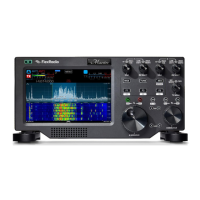FLEX-6000 Signature Series – Maestro User Guide
Copyright 2024 FlexRadio, Inc. All Rights Reserved. | Page 104
23 HOW TO OPERATE DIVERSITY RECEPTION (FLEX-6600(M) AND
6700 ONLY)
Diversity reception is a powerful method for improving the readability of a signal by using two or
more communication channels with different characteristics. Diversity reception is very useful for
aiding reception in weak and fading (QSB) signal conditions. With optimally configured antennas,
weak signal QSB copy can be improved by as much as 75%.
Two common diversity reception methods are space and polarization. These methods use separate
antennas to receive different versions of the same signal. The FLEX-6700 incorporates two fully
independent Spectral Capture Units (SCUs) that allow two separate antennas to be simultaneously
digitized. The analog-to-digital converters (ADCs) in the respective SCUs are driven from a single
clock source to provide stable synchronous reception.
Note: Since the FLEX-6500 and FLEX-6300 use a single SCU, they are not capable of diversity
reception.
For best results, antennas should be de-correlated in some way so that fading on one antenna is
likely to be seen as increased signal strength on the other antenna. De-correlation can be
accomplished by using different types of antennas (dipole and vertical), using the same type of
antenna at wide spacing (e.g. multiple wavelengths), or using the same antenna with different
polarizations (horizontal and vertical or right and left). The more de-correlated the antennas the
better, but even small amounts can be beneficial. One interesting example of the application of
circular polarization diversity on HF is discussed in the December 2010 QST article, “Gimme an X,
Gimme an O, What’s that Spell? – Radio.”
The diversity reception implementation provided in Maestro is intended for use only with
headphones. Two Slice Receivers attached to separate antennas are automatically routed to the
left and right ears so that the brain can provide discrimination between the signals. Speakers are
not recommended because they allow the audio signals to combine in the space between the
speakers to cause undesirable peaks and nulls in the sound.

